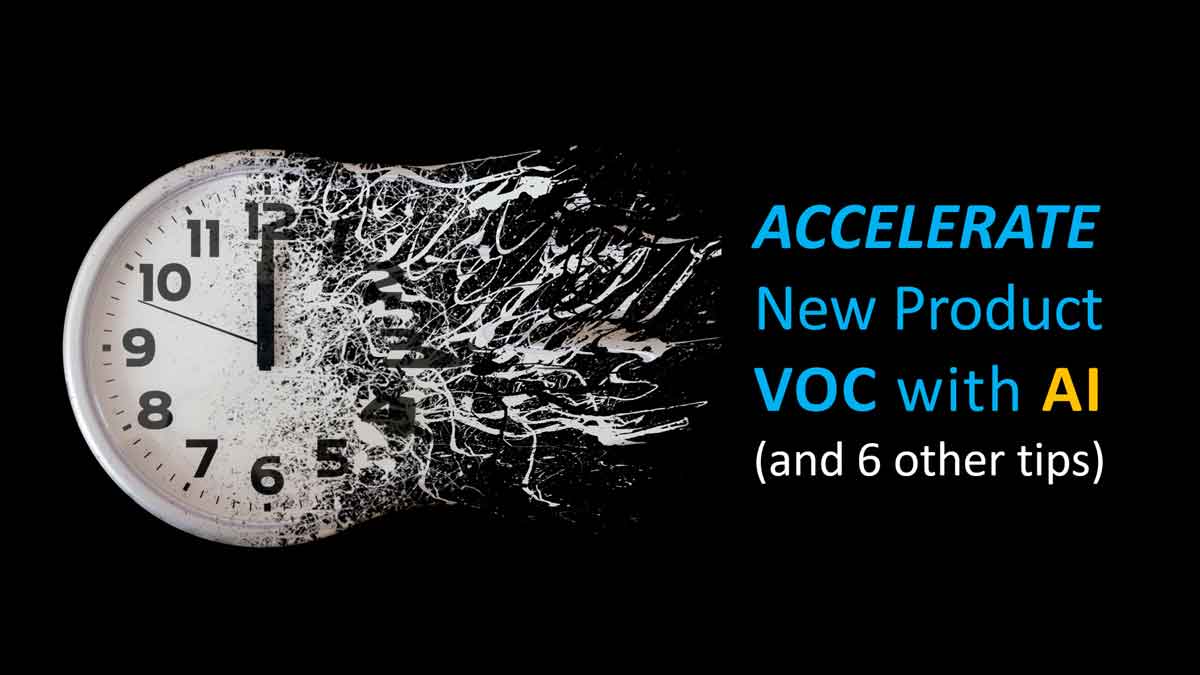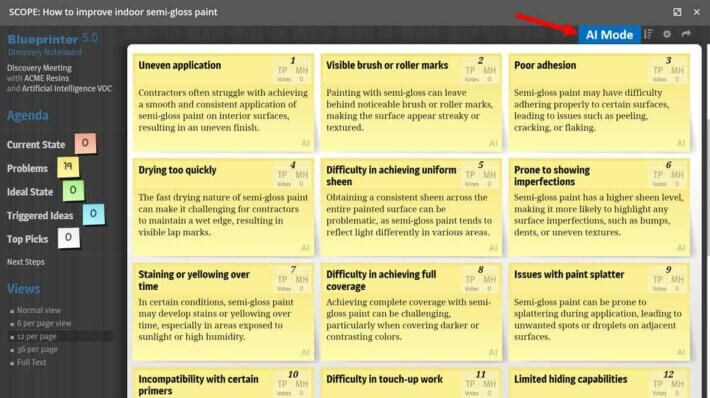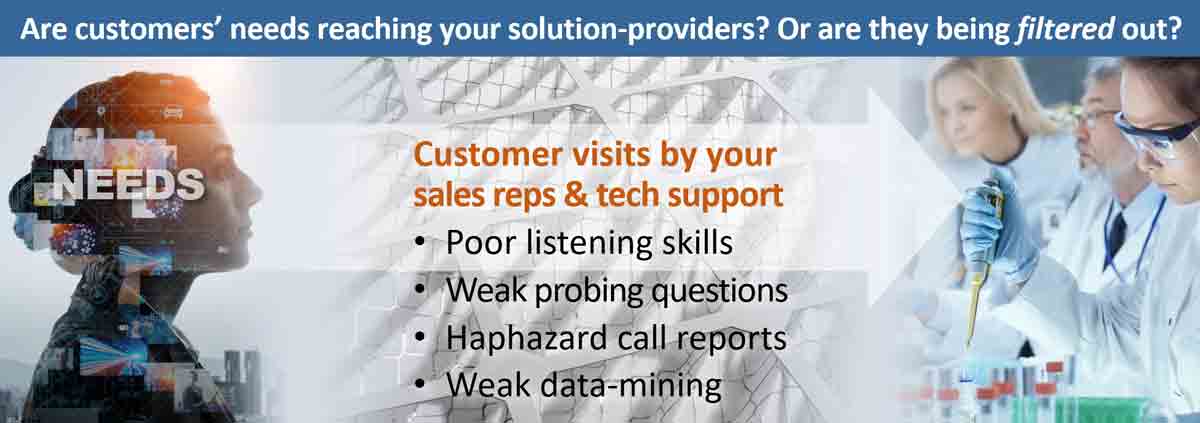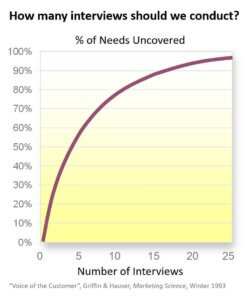Accelerate VOC interviews with AI (and 6 other tips)

What if you could finish your voice-of-customer interviews in just a few weeks, not months? We’re talking about incredibly thorough qualitative and quantitative interviews. You’ll have irrefutable evidence that eliminates most commercial risk. You’ll know exactly which outcomes the market does and doesn’t want you to improve. And you’ll have it FAST.
Here’s the good news: Given recent technology breakthroughs and many lessons learned, you can do this in a matter of weeks. Pardon me if I use New Product Blueprinting to explain how to accelerate VOC: Most of these tips are also applicable to other approaches for interviewing B2B customers.
We believe there’s great—and often unrecognized—value when you accelerate VOC interviews. If you launched a new product that generated $5 million in revenue with average margins, what would be the economic value of launching it earlier? Launching that product one month earlier generates about $80,000 of net present value, or $4000/business day. We need more innovation urgency.
Launching that product one month earlier generates about $80,000 of net present value.
Let’s begin with what we’ve learned working with many of the world’s largest B2B companies over nearly two decades:
1) You should conduct two rounds of customer interviews in your target market segment before you begin your new product development stage: qualitative Discovery interviews and then quantitative Preference interviews.
2) Qualitative Discovery interviews are important, as they eliminate errors of omission: failing to uncover customers’ unarticulated needs. No one notices these errors at the time, but they can lead to major missed opportunities in your new product launch.
3) Quantitative Preference interviews are the most critical. Here you capture 1-to-10 importance and satisfaction ratings to generate a Market Satisfaction Gap profile. Without this, our research shows most teams commit errors of commission: They try to improve the wrong customer outcomes due to confirmation bias and wishful thinking.
4) After working with hundreds of project teams, we’ve learned that the most common area for teams to get bogged down is in the qualitative Discovery phase. If they could go faster in this phase, most teams would accelerate VOC and complete their front-end-of-innovation work much sooner.
Given the last point, many of the following tips to accelerate VOC are aimed at compressing the time needed to conduct Discovery interviews. Let’s look at 7 ways to do this.
Tip 1: Interview AI (artificial intelligence) first.
Here’s how this works: Within Blueprinter® software, you can now press an “AI” button in the upper right of your Discovery noteboard. Instead of you recording needs as customers explain them during an interview… the AI engine auto-fills about 20 sticky notes in 30 seconds. See below for a sample generated for painting with semi-gloss paint.

Wait… Does this mean we don’t need to conduct Discovery interviews with humans? Far from it. But with AI you may be able to conduct fewer Discovery interviews… which is a great way to accelerate VOC.
A long time ago, researchers found that more interviews don’t lead to many more insights after a certain point. They just lead to echoes… hearing the same customer needs you’ve already heard in earlier interviews.
As shown in this chart, your most productive interviews tend to occur in the first 6-10. As my colleague, Scott Burleson, likes to say, “With AI, you don’t need to start at zero.”
With AI, you don’t need to start at zero.
In other words, you could interview AI several times and move to the right on this chart before your first “human” interviews. Why several AI interviews? You can ask it about different…
1) Jobs-to-be-done. Ask AI about the process for formulating paint, for producing paint, and for applying paint.
2) Job executors. Ask AI to list problems from the perspective of the formulating chemist, production manager, and paint contractor.
3) Job variations. Ask AI about painting interior residential walls, exterior surfaces, and commercial surfaces.
So how much could you compress your Discovery interviews to accelerate VOC? Consider four factors.
1) Errors of omission: Your main objective is to ensure you don’t miss a critical customer outcome that could have led to a blockbuster new product. This danger increases if your customers’ job-to-be-done is highly specialized, embryonic, or otherwise unlikely to be “scraped” from the internet by an AI engine. Conversely, you may need very few “human” interviews if your topic is well published on the internet.
2) Customer engagement: If you’re serving a concentrated market, with just a handful of important customers (say, automotive OEMs, aircraft builders, etc.), your Discovery interviews can help to engage and impress them… so don’t skimp on these. On the other hand, if you have hundreds or thousands of small potential customers, this engagement becomes less important.
3) Training: If you’re learning New Product Blueprinting, you’ll need to conduct Discovery interviews with humans to refine your listening and probing skills. But here’s a “workaround” if you’re struggling to schedule customer interviews: Conduct multiple Discovery interviews with your sales reps. This gives you practice and helps them see the value of these interviews.
4) Prioritization: We like to say that Discovery interviews let you diverge to all customer outcomes, and Preference interviews let you converge (prioritize) to the outcomes customers most want improved. While that’s generally true, there’s a step at the end of Discovery interviews called Top Picks, where customers identify their favorites from all recorded sticky notes. If you conduct fewer Discovery interviews, be sure to spend enough time on Top Picks, as this helps you select which outcomes to take into Preference interviews.
Depending on your circumstances, you might be able to use AI to conduct just 3-to-5 real customer Discovery interviews very quickly. Now add the following tips to accelerate VOC and complete your front-end work in record time.
Tip 2: Conduct mostly virtual VOC.
Which is better: A two-hour in-person interview or a two-hour virtual interview (conducted via Zoom, Teams, or similar)? The in-person interview is the gold standard: you can make better eye contact, watch body language, build relationships, and take a tour.
However, we know that scheduling and traveling for these in-person interviews can significantly slow your interview timeline compared to virtual interviews. With the latter, you just need to find an hour or two when everyone is available… not a day or two for your team to travel. You can even conduct several interviews in a single day… a wonderful way to accelerate VOC.

If you need in-person interviews to build relations, take tours, or “go deep,” please do so. But keep in mind that every day of delay typically reduces your net present value by several thousand dollars. To learn more about virtual VOC, download our white paper at www.virtualVOC.com.
Tip 3: Schedule Preference interviews early.
Here’s a tip to not only accelerate VOC, but also make life easier for you. As you complete each Discovery interview, thank your customer and ask if they would help you prioritize all these great ideas later. They usually say “yes” to a real-time request.
How you ask is important. Tell them you’d like to have another short Zoom or Teams call so you can a) share your preliminary industry research with them, and b) give them a chance to “vote” on what your R&D should work on.
What’s this “preliminary industry research”? These are the outcomes you’ve uncovered so far (from AI and human Discovery interviews) that you’ll bring to your Preference interviews. And their “voting” is asking them to give you 1-to-10 importance and satisfaction ratings during these Preference interviews.
Let’s say you conduct your AI “interviews” and a few customer Discovery interviews in January. Ask customers if you can share your “preliminary research” with them in February. Asking this early on will accelerate VOC and save you the hassle of trying to schedule separate Preference interviews.
Tip 4: Conduct Preference surveys.
Granted, surveys won’t work well if you’re serving a highly concentrated market, with just a few large, important customers. You just won’t have enough reliable data points. But if your target market is fragmented with lots of customers, this works well indeed.
How do Preference surveys accelerate VOC? Instead of scheduling lots of interviews, you send out survey links to many contacts at the same time. In just a matter of days, you can have an excellent data set to work with.
Blueprinter software has a function (Tool 3.5) that lets you create Outlook emails with an embedded survey link in the email body. Customers simply click this link to complete the survey, and all your charts (including Market Satisfaction Gaps) are automatically created. You can also use a third-party survey tool for this.
One caution: Unless you provide some incentive, you may get a very low response rate. Consider two incentives:
1) Enter them in a drawing for a gift card or other prize. Don’t skimp on this: If you make it a truly attractive prize, you’ll boost your response rate.
2) In some industries, customers aren’t allowed to receive a gift card. A good alternative (or supplement) is offering respondents a copy of your industry research when it’s completed. You don’t need to give them everything you’ve learned if you’re nervous about tipping off competitors. But you can usually provide an industry report they’ll value without giving up too much.

Tip 5: Train your sales team
We’ve seen some sales teams enthusiastically embrace VOC interviews for new product development. These sales professionals do a wonderful job of contacting customers and setting up these interviews. In other cases, we’ve seen sales reps fixated on “selling what they have,” instead of “learning what customers want.” In these cases, reluctance by sales colleagues can be the primary roadblock to accelerate VOC.
What to do? Consider three options:
1) Instead of interviewing real customers at first, begin by interviewing your sales team. This is great practice for your project team and helps get your sales colleagues “on board.” They enjoy being listened to and realize their customers will as well.
2) Expose your sales team to training in voice-of-customer methods they can use every day, even without a new product development project. We have a training for this, coincidentally called, Everyday VOC.
3) Change the incentive program for your sales professionals. Reward them not just as a “sales force,” but also as a “learning force.”

Tip 6: Get help for unfamiliar markets
What if you want to explore adjacent market opportunities? The companies you contact may not have a clue who you are, which makes it quite tough to secure interviews.
Your best approach is to find industry experts who already have strong relations with customers you’d like to interview. You might find such experts within consulting services, trade associations, or expert networks like GLG or AlphaSights. Start by interviewing them to learn as much as you can about this market, and then query them to see how well connected they are.
When you find the right experts, ask them to a) set up interviews for you, or at least b) give you contact names. In the latter case, be sure to cc them on your outbound email and include the expert’s name in the first line of your email: “Jill suggested I talk to you about…” This simple step can greatly accelerate VOC in an otherwise challenging market segment.
Tip 7: Dedicate sufficient resources
Many B2B companies skimp when it comes to front-end resources… and then waste far more resources in the product development stage because they’ve been so poorly “aimed.” You can beat the competition by loading up on resources for your front-end interviews. When you dedicate resources for these interviews, you’ll be amazed at how much you’ll accelerate VOC.
Don’t think of this as “adding” new resources. It’s often a matter of keeping the same resource level but moving these resources “up and out”:
- Move resources UP from the development stage to the front end.
- Move resources OUT for conversations with customers instead of ourselves.
Move your resources “up and out” to accelerate VOC.
If you want to accelerate VOC, don’t overload your project team members with many other duties. Here’s what Michael George reported in Fast Innovation:
“If you load innovators to 95% capacity utilization, on average the resulting queues will cause the lead time of the innovators’ tasks to increase four times above the level if the innovators are scheduled at only 65% utilization.”
Learning more
Much has happened in the last few years—especially with AI and virtual meetings—that lets you dramatically accelerate VOC work. We think this can be a game-changer for B2B companies eager to conduct proper front-end VOC, but reluctant to spend too much time on it. Now you can have it all… high quality insights and speed to market!
To learn more in a brief consultation, contact us at www.TalkWithAIM.com

Comments